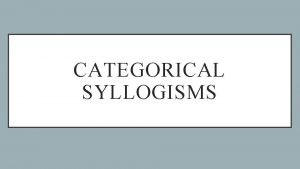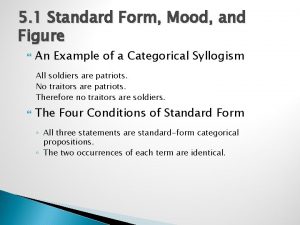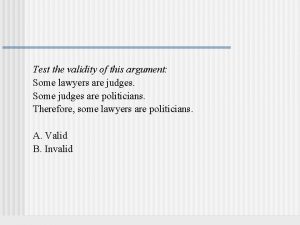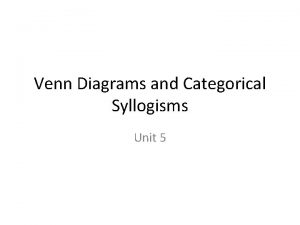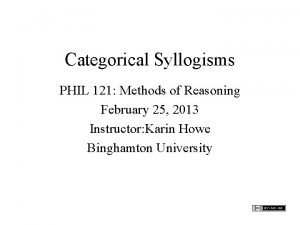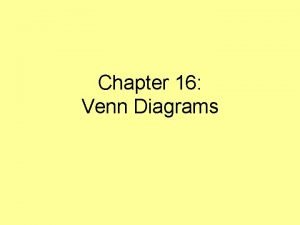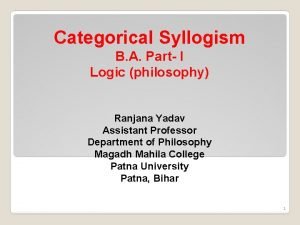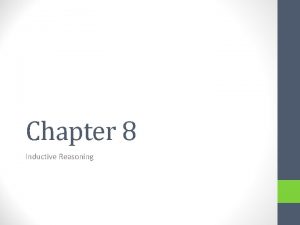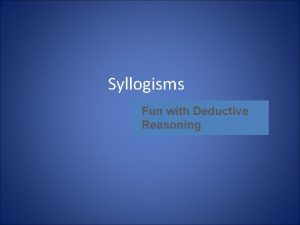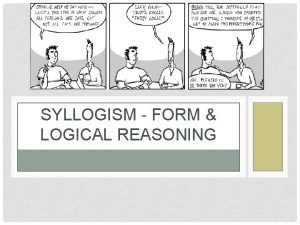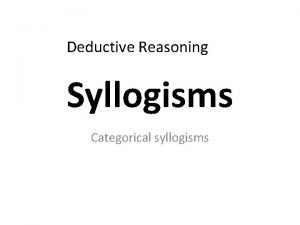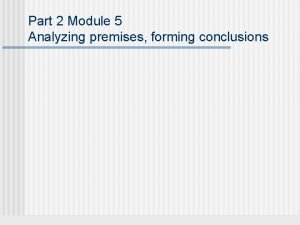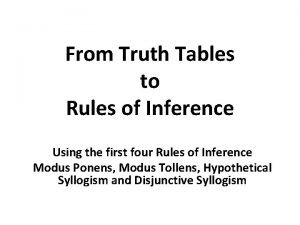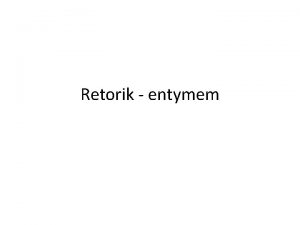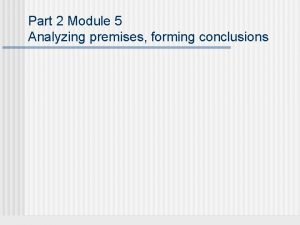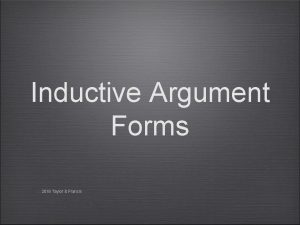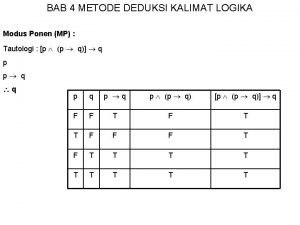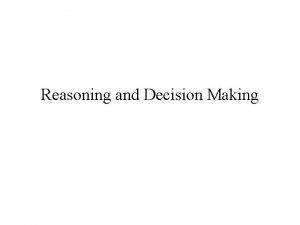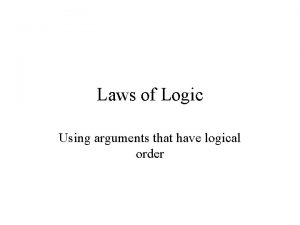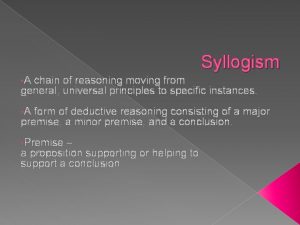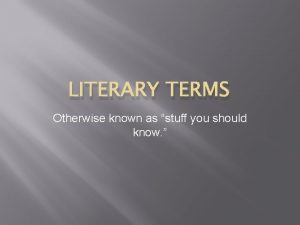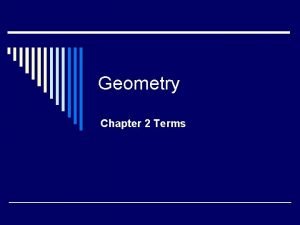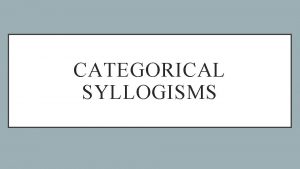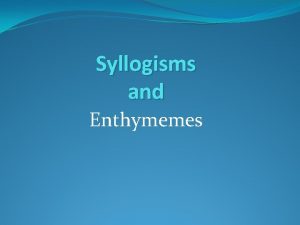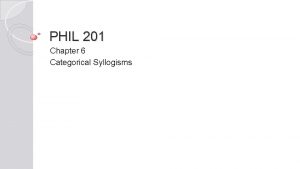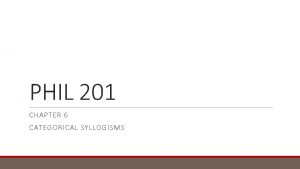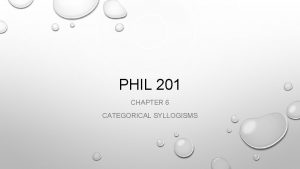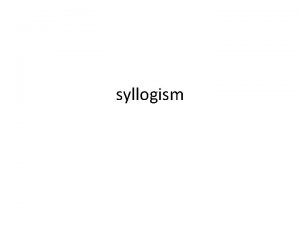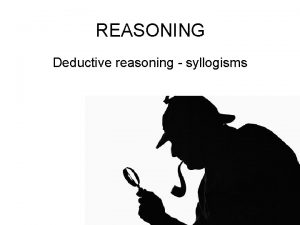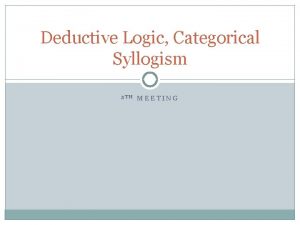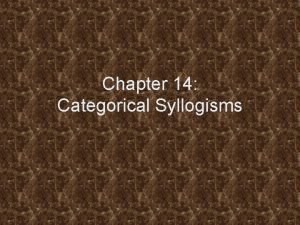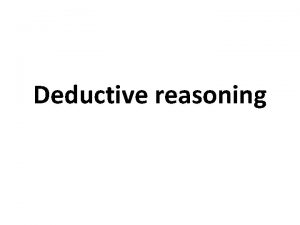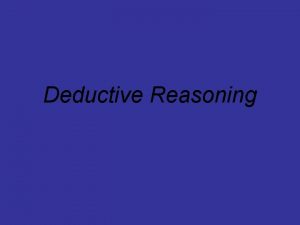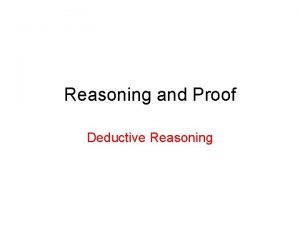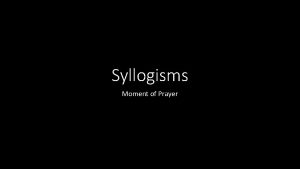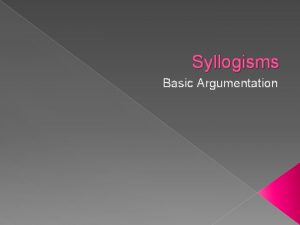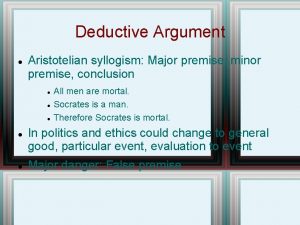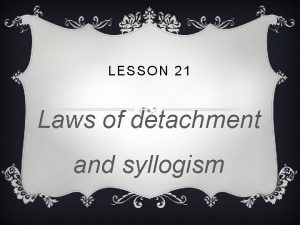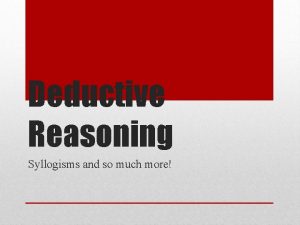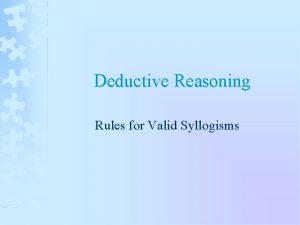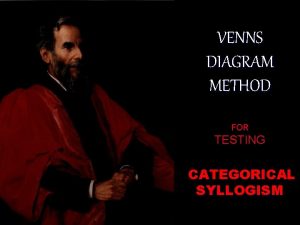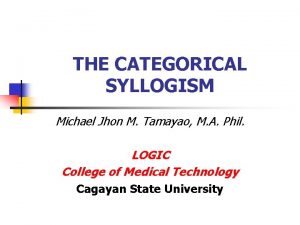CATEGORICAL SYLLOGISMS A categorical Syllogism is a deductive



























- Slides: 27

CATEGORICAL SYLLOGISMS

A categorical Syllogism is a deductive argument in which a conclusion is inferred from two premises. These argument based on the relations of classes (categories). Categorical syllogisms are deductive arguments consisting of three categorical propositions, which contain 3 terms. Each of these 3 terms occurs exactly twice.

1 1 1. No bananas are animals. 1 2 2. Some mammals are animals. 2 2 3. Therefore, some mammals are not bananas. Term 1: Bananas Term 2: Animals Term 3: Mammals

STANDARD-FORM CATEGORICAL SYLLOGISM A syllogism is in standard form when: 1. Its premises and its conclusion are in categorical form: A, E, I, O. 2. There are exactly 3 different terms. 3. Each term occurs twice. 4. The major premise is always stated first, the minor second, and the conclusion last. 5. The middle term NEVER occurs in the conclusion.

TERMS OF SYLLOGISMS: MINOR, MAJOR, MIDDLE To identify the terms by name we look at the conclusion: 1. No trees are humans. 2. Some babies are humans. 3. Therefore, some babies are not trees.

The conclusion: Some babies are not trees. Subject: babies Predicate: trees. The predicate of the conclusion is the Major term. The subject of the conclusion is the Minor term. The term that does not occur in the conclusion—humans—is the Middle term.

The premise containing the major term, is the major premise. The premise containing the minor term, is the minor premise.

THE MOOD OF THE SYLLOGISM

The “Mood” of a syllogism is determined by the types of categorical propositions it contains. The mood is represented by 3 letters: First letter names major premise; second letter names the minor premise; the third names the conclusion.

1. No trees are humans. = E 2. Some babies are humans. = I 3. Therefore, some babies are not trees. = O The mood of this syllogism is EIO.

THE FIGURE OF THE SYLLOGISM

To precisely characterize the logical form of a syllogism, we need to know more. We need to know the Figure Let’s see why: Compare 2 syllogisms, A and B, which have the same mood AII: (A) (B) 1. All scientists are college graduates. 1. All artists are egoists. 2. Some athletes are college graduates. 2. Some artists are Americans. 3. So, some athletes are scientists. 3. So, some Americans are egoists.

Notice that both syllogisms have the same form AII, but (A) is invalid and (B) is valid. Let’s see what makes one valid and the other invalid. Let’s assign the letter S for the minor term—the subject of the conclusion—the letter P for the major term—the predicate of the conclusion—and the letter M for the middle term: (A) 1. All scientists are college graduates. = All P are M 2. Some athletes are college graduates. = Some S are M 3. Therefore, some athletes are scientists. = Some S are P Notice: The middle term is the predicate term of both the major and minor premises.

Again, let’s assign the letter S for the minor term—the subject of the conclusion—the letter P for the major term—the predicate of the conclusion—and the letter M for the middle term: (B) 1. All artists are egoists. = All M are P 2. Some artists are Americans. = Some M are S 3. So, some Americans are egoists. = Some S are P Notice: The middle term is the subject term of both the major and minor premises.

(A) (B) All P are M All M are P Some S are M Some S are P Some M are S Some S are P To precisely describe the form of a categorical syllogism, we must state its mood and its figure. The figure is determined by the position of the middle term in the premises. And depending on the position of the middle term in the premises, a syllogism can be valid or invalid.

SYLLOGISMS HAVE ONLY 4 POSSIBLE FIGURES

FIGURE 1 The middle term is the subject of the major premise and the predicate of the minor premise. M – P S – M S – P

FIGURE 2 The Middle term is the predicate of both the major and minor premises. P – M S – P

FIGURE 3 The middle term is the subject of both the major and the minor premises. M – P M – S S – P

FIGURE 4 The Middle term is the predicate of the major premise and the subject of the minor premise. P – M M – S S – P

A TRICK TO REMEMBER A way to remember the 4 figures is by looking at the 4 figures horizontally: 1 2 3 4 M – P P – M S – M M – S S – P Notice the pattern of the Middle term forming a W shape:


Any standard-form categorical syllogism is completely described when we specify its mood and figure. 1. No bananas are animals. = E 2. Some mammals are animals. = I 3. Therefore, some mammals are not bananas. = O The mood of this syllogism is EIO. And its figure is 2. Its complete description is EIO-2.

If we list all categorical syllogisms by mood beginning with AAA, AAE, AAI, AAO…all the way to OOO we would have enumerated 64 moods. And since each mood can occur in each of the 4 figures, 64 x 4 = 256.

EXERCISES Rewrite each of the following syllogisms in standard form, and name its mood and figure. Procedure: Identify the conclusion. Identify its predicate term and its subject term. Its predicate is the major term. Its subject is the minor term. Identify the major premise (the one with the major term) Rewrite the argument in standard form. Name the mood and the figure.

1. No nuclear-powered submarines are commercial vessels. So no warships are commercial vessels. Because all nuclear-powered submarines are warships. 2. Some evergreens are objects of worship, because all fir trees are evergreens, and some objects of worship are fir trees. 3. All artificial satellites are important scientific achievements; therefore, some important scientific achievements are not US inventions, inasmuch as some artificial satellites are not US inventions.

4. No television stars are certified public accountants, but all certified public accountants are people of good business sense; it follows that no television stars are people of good business sense. 5. Some conservatives are not advocates of high tariff rates, because all advocates of high tariff rates are Republicans, and some Republicans are not conservatives. 6. All proteins are organic compounds, hence all enzymes are proteins, as all enzymes are organic compounds.
 Standard form syllogism
Standard form syllogism Categorical syllogism
Categorical syllogism Syllogism definition literature
Syllogism definition literature Venn diagram for categorical syllogism
Venn diagram for categorical syllogism Phil 121
Phil 121 Categorical syllogism venn diagram examples
Categorical syllogism venn diagram examples Logical syllogism
Logical syllogism What is statistical syllogism
What is statistical syllogism Syllogism examples
Syllogism examples Syllogism english
Syllogism english Rhetorical devices in letter from birmingham jail
Rhetorical devices in letter from birmingham jail Major premise in syllogism
Major premise in syllogism Forming conclusions
Forming conclusions Rules of inference
Rules of inference Reflection statement
Reflection statement Entymem
Entymem Deductive reasoning definition
Deductive reasoning definition Tollens reduction
Tollens reduction Fallacy of inverse
Fallacy of inverse Statistical syllogism vs inductive generalization
Statistical syllogism vs inductive generalization Modus
Modus Conditional syllogism
Conditional syllogism Law of detachment geometry
Law of detachment geometry Syllogism
Syllogism Transitive reasoning examples
Transitive reasoning examples Chain syllogism
Chain syllogism Juxtaposition vs paradox
Juxtaposition vs paradox Paragraph proof geometry
Paragraph proof geometry
